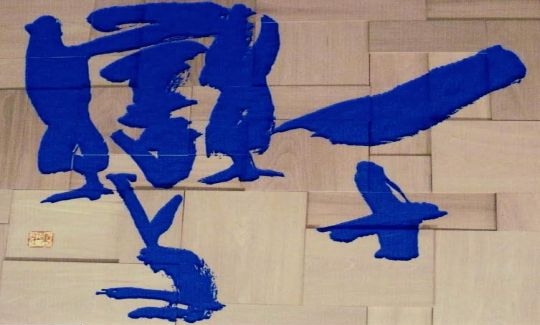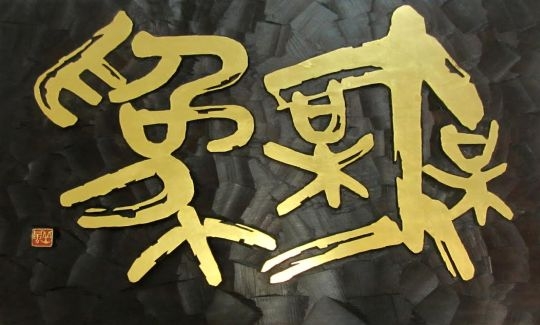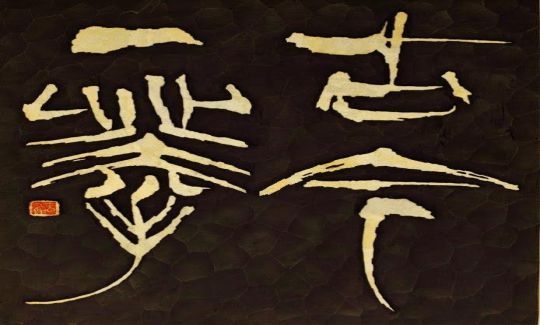Calligraphy and Kokuji
The Association for International Advancement of Calligraphic Culture
More info:
04-6030800Calligraphy and kokuji (symbols carved on wooden boards) are crafts that originated in China and were brought to Korea and Japan. Creating kokuji demands prior knowledge of calligraphy, painting and wood-carving. While phonetic scripts were developing in the West, based on pronunciation, in China they were using the pictogram, derived from the meaning of a word. Writing was integral to the other arts, in particular to painting. In a Chinese dictionary from the first century BCE the same ideogram is used for ‘write' and ‘paint'. It represents a hand holding a brush and outlining the boundaries of a field, and many classic calligraphic strokes are still used in painting. Indeed, many calligraphers are adept at painting bamboo and other plants, for which the brushstrokes are similar to those used in calligraphy.
The artist and the calligrapher use the same tools and materials - brush, paper (or silk) and ink. The fude, the painting and writing brush, is composed of a bamboo shaft topped by a head of fine fur fibres. Sumi, the ink, is made of powdered charcoal of pine wood, vegetable oils, and glue which was originally made from animal hides. This compound is moulded into a solid stick, of which the end is then rubbed in water in a stone dish (suzuri) to a consistency suitable for painting and writing. The lines, marks, and intensity of colour are controlled by the force applied to the brush and the amount of ink. Paper and silk are the usual materials. This paper originated in China in the second century BCE, and was first made in Japan in the fifth century. Washi (Japanese paper) is the most widely used type, and is made from the inner surface of the bark of the mulberry tree (kozo).
The Japanese adopted the Chinese ideograms when Buddhism reached Japan during the reign of Prince Shotoku (574-622). These are known as kanji (Han letters) from the Chinese Han Dynasty (202 BCE-220 CE) when their final form was decreed. With the kanji the Japanese incorporate phonetic signs called kana, among them hiragana - trailing letters, and katakana - incisive letters, developed in Japan in the 9th century. Hiragana is written with cursive strokes, while those of katakana are straight. Both Japanese and Chinese write in columns from right to left, or in lines from left to right as in English, but without punctuation.
Chinese scripts evolved from the kobun, the ancient script based on archaic symbols which were incised on the bones of animals, tortoiseshell, bronze or stone, and were also used for prophecy. The script was graphic, representing its content. Local variants of the ancient ideograms in the independent kingdoms of China were in use until 300 BCE.
With the unification of China under the Qin dynasty (221-207 BCE), scripts were also unified into the tensho (seal-writing) style. This script, in which the ancient form of the ideograms is employed, was used for carving seals. It is difficult to read, and equally difficult to forge. Reisho, the "clerk's script", which is more abstract, also appeared during that era, apparently because of all the clerical work required at the time.
At the close of the Han Dynasty other styles appeared, includingkaisho, the official script, in which the characters are written out fully in the square format which is the basis for printed texts.Gyosho, the flowing style, is a quicker way of writing kaisho, the characters being cursive and joined, making it easier to write and harder to read. In sôsho, a grass-like form, the stiff contours flow into each other with many curlicues and much abstraction. Reading and writing this script is possible only for specialists. It is also the preferred style of the Zen monks, due to its fluidity and speed. The strokes of this style reveal the freedom and spontaneity of the Zen spirit, achieved after long periods of meditation.
In ancient China there developed a tradition of carving signs on stone or wooden panels for various purposes, including for printing. Indeed, printing from carved wooden blocks had already begun in the 8th century. The printer carved a reversed copy of a text or picture in relief, inked the carving, and applied it to the paper.
Symbols carved on wood were also used as signs for businesses (kanban). In a Japanese regulation from the year 701 (Taihô) there is a reference to the matter of signs: "When a man sets up a stall in the market each month in the city, he must give details of his stock on a sign". In Japan, a wooden sign from the Kamakura era (1192-1333) has been preserved, and such signs are still hung at the entrance to Buddhist temples. From 1661 to 1672 the kanji symbols became popular. In the Edo period (1603-1868) signs with a play on words appeared, such as kanban musume, meaning "sales girl", orkanban wo orosu, meaning "closing the shop". They still use such word-play today. Simple signs did not include words, so that people who were illiterate could understand them - a depiction of prayer beads or a barrel of saké was sufficient to convey the message. In modern times, wooden signs (which were not traditionally considered as art) have been replaced by shiny metal or neon, and it is hard to find a wooden sign, except perhaps outside an old local shop. The charm of the old signs lies in their bold and complex graphic design, and as documents of the trades and tastes of the merchant classes in the Edo and Meiji periods (Meiji: 1868-1912). The kanban symbols belong to Japan's past, and convey a well-developed sense of business acumen, and there are still a few craftsmen makingsenjagaku signs for Japanese firms.
The art of carving kanji symbols on wood has gained new impetus in modern times. Today's kokuji artists have turned this tradition into an art in its own right. They usually use katsura wood (Japanese maple). They first prepare a pen and ink sketch which they transfer to tracing paper and affix to the wooden panel with the appropriate glue. They then carve out the script (intaglio) or the surrounding area (relief) with special knives and chisels. First the vertical lines are carved, so that the craftsman will not accidentally damage the ideograms. A 3-centimetre thick slice is taken from the trunk of the tree, selected with great care for each specific work, and with regard to the alignment of the wood fibres. There are several modes of carving for large panels - waves, squares, shell-shapes of different sizes (kamakurabori-fu), and others. Finally the symbols and/or the background are painted. The most popular colours are green, blue, white and gold, and the depth of the carving endows the work with a sculptural quality.
Many kokuji artists prefer the tensho style, which is like painting. For example, the kanji ideogram for "deer" resembles a stag with noble horns. Ideograms for "mother" and "child" resemble a mother and her son. At the same time, the kokuji artists succeed in preserving the vitality and beauty of the Japanese calligraphic brushstrokes.
We are very proud to present the art of kokuji for the first time in Israel. The carving techniques and creation of kokuji are the outcome and achievement of many generations of craftsmen, and today's artists are preserving these techniques for future generations. The exhibition comprises sixty calligraphic and kokujiworks by sixty different artists of the first rank. We are very grateful to the Association for the International Advancement of Calligraphic Culture, by whose courtesy the exhibition is presented, to Master Usuda Tosen and Mr. Okada Shinkichi for their great help in organizing the exhibition in Japan, and to all the participating artists.



